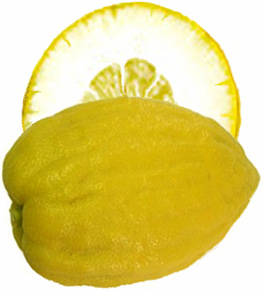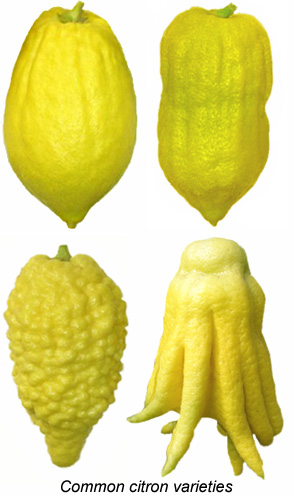Citron in Sicily - Best of Sicily Magazine (original) (raw)

 The dignified citron suffers a perpetual identity crisis, almost a kind of botanical identity theft inflicted by its distant cousin, the humble lemon. There seem to be two reasons for this. In certain languages, such as French, citron refers to the lemon, while the fruit of certain citron varieties resembles a lemon and has a rather similar taste. In French, citron is cédrat. The citron is viewed by many as eccentric, even esoteric, all but unknown.
The dignified citron suffers a perpetual identity crisis, almost a kind of botanical identity theft inflicted by its distant cousin, the humble lemon. There seem to be two reasons for this. In certain languages, such as French, citron refers to the lemon, while the fruit of certain citron varieties resembles a lemon and has a rather similar taste. In French, citron is cédrat. The citron is viewed by many as eccentric, even esoteric, all but unknown.
The fruit is mostly a thick, white rind. This, as well as the juicy pulp (flesh) and skin (peel), are edible. The skin, in particular, is often used in baking. The citron has a bitter taste. The sugared rind is known as succade.
The geographical origin of citrus medica (citron's official name) during historic times is uncertain, though India and Yemen are often suggested. In fact, all citrus species probably originated in southeast Asia long ago. In antiquity citron was used medicinally as a cure for seasickness and other ailments, and sometimes as an antidote to certain poisons. It is a good source of soluble fibre. In Persia it was traditionally used to make jam, and in India citron is chopped and pickled in preserves. The Koreans make citron tea.
As the etrog (its Hebrew name), the citron is used ritually byJews at Taberna (the Feast of the Tabernacles during Sukkot). According to the Torah, the Jews brought the fruit with them during the Exodus, and indeed ancient Egyptian art depicts the citron. There exists a theory that the citron was the forbidden fruit of the Garden of Eden.
 Citron was probably introduced in Sicily during the Greekor Roman periods, and figures such as Alexander the Great are sometimes identified as having brought it westward. Pliny the Elder writes of it. In mosaics and other works of art of the ancient era the yellow fruits sometimes identified as lemons are actually citrons. Lemons and oranges, though known to the Romans, were first widely cultivated in Sicily by the Arabs. Citron seeds uncovered in Mesopotamian excavations date from circa 4000 BC (BCE). It was the Spaniards who brought the fruit to the New World.
Citron was probably introduced in Sicily during the Greekor Roman periods, and figures such as Alexander the Great are sometimes identified as having brought it westward. Pliny the Elder writes of it. In mosaics and other works of art of the ancient era the yellow fruits sometimes identified as lemons are actually citrons. Lemons and oranges, though known to the Romans, were first widely cultivated in Sicily by the Arabs. Citron seeds uncovered in Mesopotamian excavations date from circa 4000 BC (BCE). It was the Spaniards who brought the fruit to the New World.
There are various varieties of citron, including the fingered citron shown here. When ripe, the citron fruit is deep yellow in colour, almost orange. The variety most widely cultivated in Sicily is the Diamante. In Sicily the citron is usually propagated from cuttings rather than seeds, so most trees are "clones." The trees usually begin to bear fruit after around five years.
Like the lemon, the citron bears fruit several times during the year. It is, of course, cultivated on warmer climates where the ground never freezes. this includes most of Sicily. The tree grows to a height of almost five meters (16 feet). The oval fruit, which is very fragrant, varies in size, easily reaching 25 centimetres (10 inches) in length.
The citron is thought to be one of the oldest "pure" citrus species, along with the mandarin orange, papeda and pummelo. The various "domesticated" orange and lemon varieties, on the other hand, developed through random hybridisation over many millennia. The citron, which self pollinates, is probably the oldest of all these fruits. In Neolithic times it was probably more widely cultivated than either the lemon or the orange. It is probable that the citron was displaced by the lemon over time because the latter is easier to grow and, of course, juicier.
Perhaps it was destiny that this most unusual fruit was meant to be appreciated most by God's Chosen People.
About the Author: Roberta Gangi has written numerous articles and one book dealing with Italian cultural and culinary history, and a number of food and wine articles for Best of Sicily Magazine.